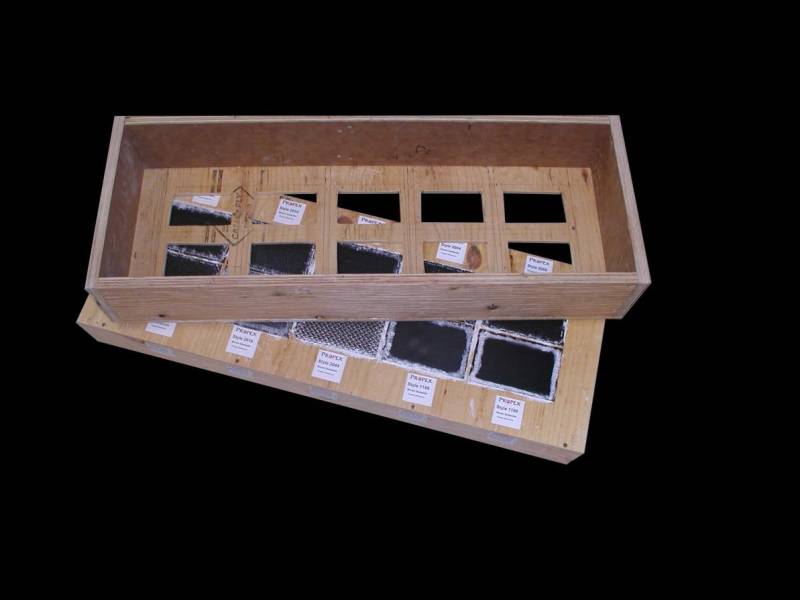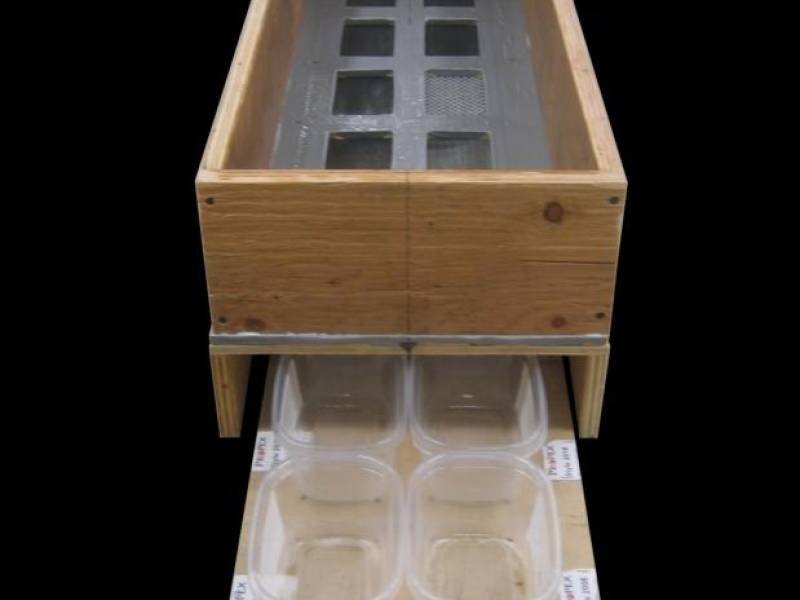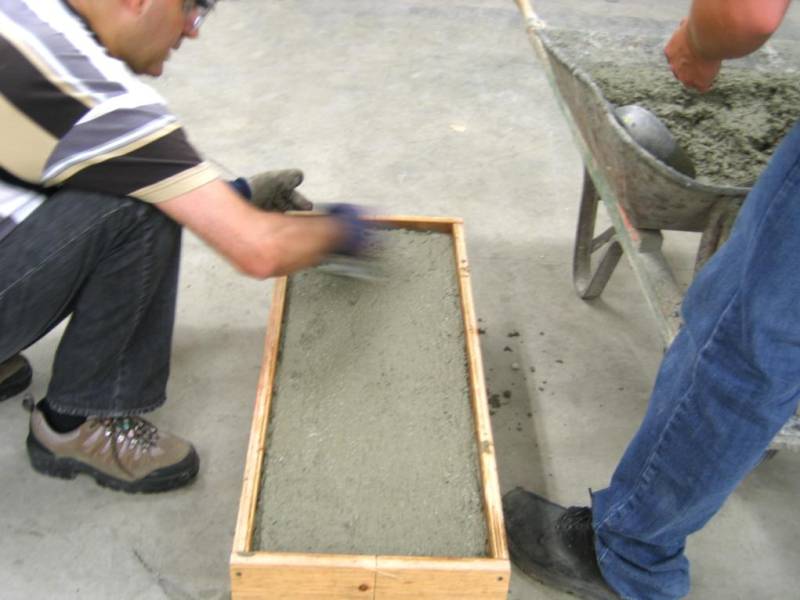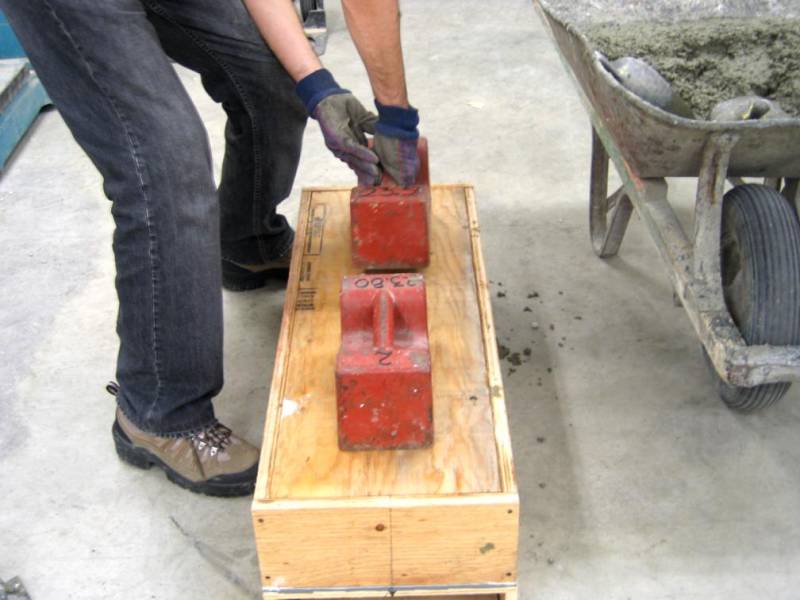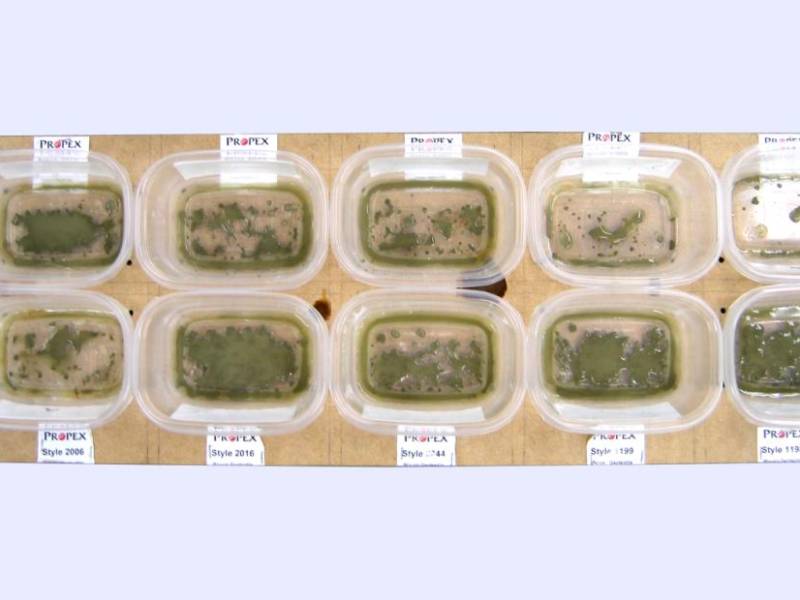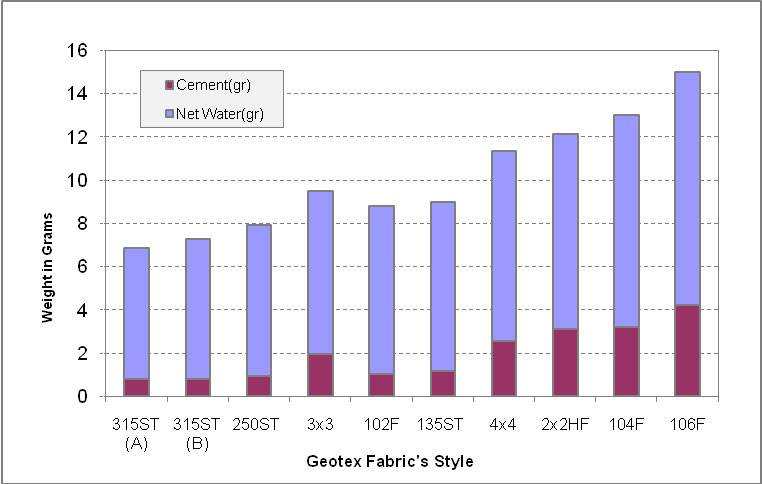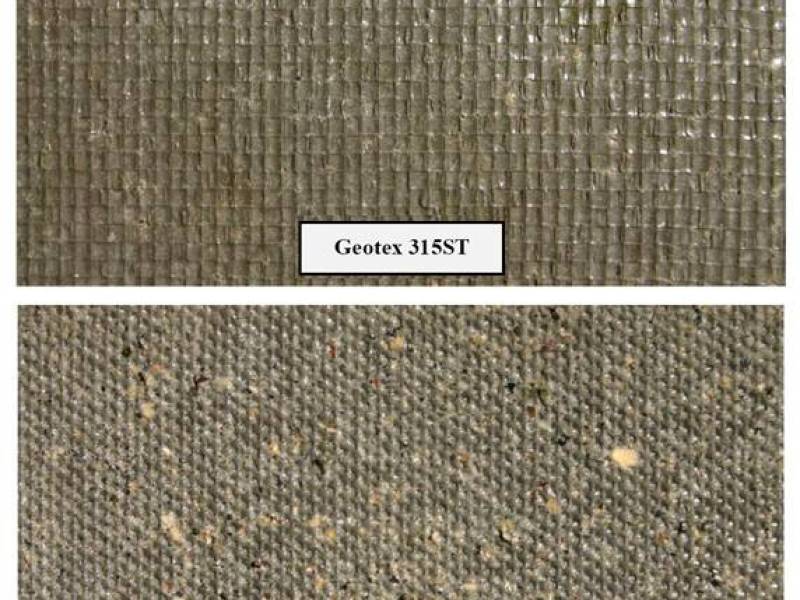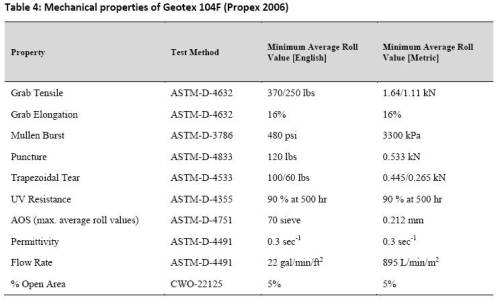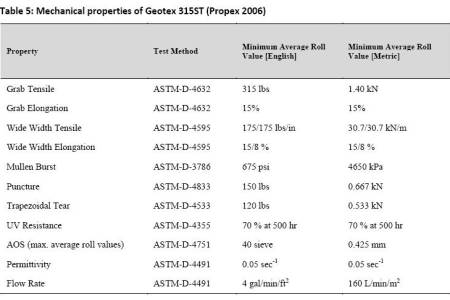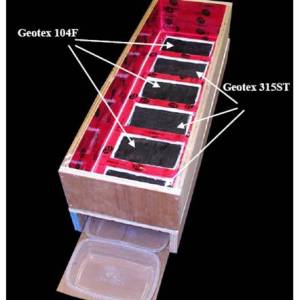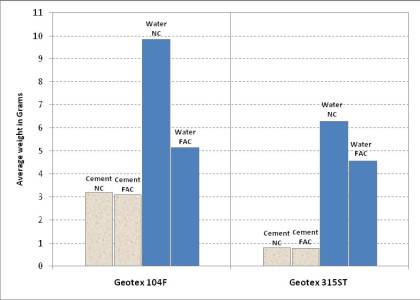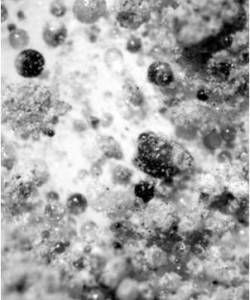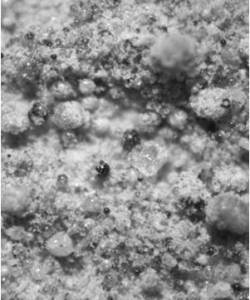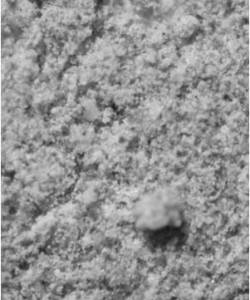This is an old revision of the document!
−Table of Contents
Selection of Fabrics
Choice of Fabrics
Use of geosynthetics in civil engineering industry started as early as 1950’s in the United States. More research and development on geotextiles was also conducted in the Netherlands, Britain and Germany [1]. Geotextiles can be either woven or nonwoven fabrics. There are over 100 different applications for the use of geotextile fabrics in civil engineering industry [2]. The material used in the fabrication of geotextiles is normally a type of polymer. Polymers generally used in the geotextile industry consist of PE (Polyethylene or Polythene), PP (Polypropylene), PVC (Polyvinyl Chloride), PET (Polyethylene Terephthalate), PS (Polystyrene), PA (Nylons), and Cellulose [3].
Woven PP and PE are produced with high tensile strength and low elongations. They have high capability for filtration and distribution of load and manufactured from individually woven, ultraviolet (UV)-resistant Polypropylene fibers [4]. Geotextiles are produced as non-coated or coated using a layer of PE. Geotextiles are widely available in the market and their price rage varies between 1 to 1.6 Canadian dollar per square meter (10 to 15 Canadian cents per square foot) [5]. The main use of Geotextiles is the stabilization of soil but some builders, architects and researchers have adopted them to be used as formwork for concrete.
In 1960 Felix Candela used burlap (jute) to form his concrete shells [6]. A decade later, Miguel Fisac used plastic sheets as fabric formwork and in 1980’s Bindhoff [7] and Lamberton [8] used Nylon fabrics. PE and PP woven fabrics became commercially available in mid 1980’s. Use of PE and PP woven fabrics as formwork for concrete was introduced in late 1980’s by Mark West and Richard Fearn more or less at the same time along with Kenzo Unno who used a plastic construction scaffolding netting as concrete formwork.
Specific brand name of Geotex geotextile was considered as the production line of choice in this research study for two reasons. This product was available in Winnipeg with a very low price of about one Canadian dollar per square meter (10 cents per square foot) [5] and has been used for projects at C.A.S.T. over the last couple of years. Of course, future studies could be conducted studying other products available worldwide, many of which share similar, if not identical, properties as those produced by Geotex.
In order to study specific effects on concrete strength and quality obtained by using commercially available woven polyolefin fabrics or geotextiles, it was necessary to form concrete cylinders using a variety of fabrics and concrete mix designs. A fabric used as concrete formwork must be strong enough to carry the hydrostatic pressure and the hoop tension imposed by wet concrete. In addition, it should be adequately porous to allow discharge (bleeding) of the excess mix water from the fresh concrete while preventing the loss of solid elements (fines) particularly cement and flyash particles [8].
To reduce the number of samples to a manageable number, a test was designed to determine the bleeding characteristics of the woven fabrics available in the Geotex catalogue and hence their suitability for formwork. Fabrics with a tendency of allowing cement paste bleeding were not desirable. Nine types of available structural, woven fabrics were installed at the bottom of a wood box over separate openings. Plastic containers were placed underneath each fabric sample to collect the water and cement paste residue that would bleed through the fabric (Figure 6). All fabrics used in this research study are polypropylene woven monofilament calendered (a process in which rolls of textile are passed through pairs of hot rollers to give them a shiny surface) and stabilized to resist degradation due to ultraviolet exposure.
Fabric samples provided by Geotex Fabric Incorporation were available in 100 by 150 mm pieces. This, in turn, dictated the dimensions of the openings of the wood box. Nine available fabric samples were sandwiched between two 900 by 300 mm half inch plywood sheets. The samples were carefully attached by staples to the plywood and sealed with caulking in order to prevent cement paste bleeding out from the seams (Figure 7).
The surface of the plywood was fully covered with a waterproof tape (duct tape) in order to prevent plywood from absorbing any water from the concrete. This also helped the hardened concrete to be easily released from the box. The need for releasing the hardened concrete was considered so that the imprint of the fabrics created on surface zone of the concrete could be studied later on to evaluate the surface appearance of the castings(s).
Labelled plastic containers were installed under the box (Figure 8) to collect bled water and cement paste. The weight of the empty plastic containers was recorded first and weighed again after the bleeding of the concrete had stopped; the difference was the weight of the bled water and cement paste. Collected bled materials were then left to dry and reweighed to determine the amount of water and cement in the paste respectively.
Fabric Tests Using Normal Concrete
Fresh concrete was poured inside the box (Figure 9) and then vibrated. Some pressure (46 kg, using the available weights) was applied to accelerate the bleeding process (Figure 10). As soon as the bleeding stopped, a comparison was made between individual fabrics using the weights of the collected water and cement paste that bled through each fabric (Figure 11). The amount of water and cement passed through each fabric sample were very close to each other. Therefore, to be able to choose suitable fabrics for future tests, we examined separately the amount of passed cement or water separately as well as the surface quality of the concrete.
As seen in Figure 12, the least amount of bleeding occurred with Geotex 315ST. Geotex 106F (previously known as Propex 1198) on the other hand, had the maximum bleeding ratio in both water and cement. Visual inspection of the hardened concrete taken out of the box concluded that Geotex 315ST had the best texture produced with the least amount of air holes and overall imperfections. Geotex 106F showed lack of fine aggregate on the surface and a porous surface (Figure 13).
Since selecting two types of fabric representing the least and the most bleeding was the target, two fabrics of Geotex style 315ST and 104F (previously named Propex 1199) were selected. Geotex 104F was selected instead of Geotex 106F because it bled less cementitious material while it had large amount of bleed water. Table 4 and Table 5 provide the mechanical properties of both selected fabrics in detail.
Fabric Tests Using 30% Flyash Concrete
There are reports on fine additives such as Silica fume having the tendency to clog filter fabrics associated with permeable rigid formworks or drainage formliners [9]. Mixes of normal concrete on the other hand, have not shown any significant blockage in the formwork liner [10]. Generally, particles of a typical silica fume are smaller than 1 micron [11] while the average diameter of a typical cement particle is approximately 10 μm [12]. The size of the spherical particles of the fly ash ranges between 10 and 100 micron [13]. Herein, another experiment was conducted to observe if flyash particles are able to clog the pores of the fabrics used in this research study. Using the two selected fabrics from the first box test, a second box was made and new experiment (Figure 14) was conducted with 30% type C flyash added to the mix design.
Similar to the first box test, bled water and cement paste from the fabrics were collected in containers and weighed in wet and dry form to measure the amount of water and cementitious materials bled through the two fabrics. Since only 6 pieces of fabric were installed in this box (three samples of Geotex 315ST and three samples of Geotex 104F), individual samples had a larger area exposed to the fresh concrete. Therefore, before deriving the results, corrections were applied to the areas to make the results consistent with the first box test results.
Results
As seen in Figure 15, each fabric bled almost the same amount of cementitious material when exposed to normal concrete and flyash concrete. Both fabrics bled less water when exposed to flyash concrete meaning that some clogging happened when cementitious paste tried to pass through the fabric. It is hypothesized that this is caused by the increase in the amount of very fine particles in the flyash mix.
In order to investigate characteristics of collected dried cementitious material from this experiment, dry bled paste powder was examined under a stereoscopic zoom microscope (Nikon SMZ800) using maximum magnification of 378x to observe if flyash bled through the fabrics. Dried passed cementitious material was set under the microscope and the visual results were compared to both pure flyash and pure cement. Based on observations, Geotex 315ST did not bleed any flyash at all while Geotex 104F which has larger pores let a small amount of flyash bleed out (Figures 16 a,b,c). As seen in Figure 15, Geotex 315ST bled much less cementitious material compared to Geotex 104F which is caused by the size of its openings and their potential clogging by flyash particles.
Additionally, when exposed to flyash concrete, Geotex 104F bled much less water comparing to the time when normal concrete was used. Since the amount of passed cementitious material that passed through each fabric in both normal and flyash concrete was constant, the amount of bleeding water became a definitive factor in this comparison test. When flyash concrete was used, Geotex 104F showed about 48% reduction in amount of bled water (from 9.85 gr down to 5.15 gr) compared to water bled from normal concrete. While Geotex 315ST showed only 27% reduction in bled water (from 6.28 gr to 4.56 gr) due to clogging effect. This indicates that Geotex 104F is susceptible to clogging when flyash concrete is used. Compared to its use with normal concrete, Geotex 104F looses less water and air bubbles when exposed to flyash concrete. Consequently, when flyash concrete is the concrete of choice, use of textile with smaller openings is recommended.
See Also
[1] Comments by RPS on Discussion page on test box construction, Figures 8 and 14. [2] Place text here.
References
[1] Bruun, Per. Port Engineering. Houston: Gulf Publishing Co., 2000.
[2] Suits, L. D. “The Use of Geotextiles in Transportation Facilities.” In High-tech Fibrous Material, by Tyrone L. Vigo and Albin F. Turbak, 358-375. Washington DC: American Chemical Society, 1991.
[3] Bokuniewicz, Henry. “Geotextile Applications.” In Encyclopedia of Coastal Science, by Maurice L. Schwartz, 407-408. New York: Springer Netherlands, 2005.
[4] Propex. 2006. http://www.propexinc.com/ (accessed June 29, 2009).
[5] Brock White Company, LLC. Brock White. 2009. http://www.brockwhite.com/ (accessed August 13, 2009).
[6] Faber, Colin. Candela/The Shell Builder. New York: Reinhold Publishing Corp., 1963.
[7] Bindhoff, Eduardo W., and King, John C. “World’s Largest Installation of Fabric-Formed Pile Jackets.” Civil Engineering—ASCE, 1982: Vol. 52, No. 3: 68-70.
[8] Lamberton, Bruce A. “Fabric Formwork for Concrete.” Concrete International, 1989: December Issue: 58-67.
[9] Malone, Philip G. Use of Permeable Formwork in Placing and Curing Concrete. Vicksburg: U.S. Army Engineer Research and Development Center, 1999.
[10] Nolan, E., Basheer, P. A. M., and Long, A. E. “Effects of Three Durability Enhancing Products.” Construction and Building Materials, 1995: Vol. 9, No. 5: 261-272,.
[11] Malhotra, V. M., and Carette, G. G. “Silica fume, A Pozzolan of New Interest.” Concrete Construction, 1982: May Issue: 443-446.
[12] Kosmatka, Steven H., Panarese, William C., Gissing, Kathaleen D., and MacLeod, Norman F. Design and Control of Concrete Mixtures. Ottawa: CPCA, 1995.
[13] FHWA. Fly Ash Facts for Highway Engineers. Aurora: U.S. Department of Transportation, 2003.

